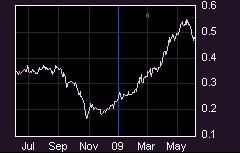
www.sharesinvestment.com
LONG BEFORE the market began its astonishing rally, shares of Pharmaceutical counter Tianjin Zhong Xin Pharmaceutical Group (TJ) were rising steadily.
From US$0.18 at the end of November last year, it closed at US$0.48 last Friday (June 5), up 167%.
S-chip with strong corporate governance
TJ is listed both on the local stock exchange (since 1997) and the Shanghai Stock Exchange (since 1992), which means the company has to be scrutinized by both sets of rules and regulations of the two exchanges, therefore further enhancing its corporate governance.
Owning 50 branch companies and subsidiaries with holding and participating stocks, TJ’s sales revenue has averaged Rmb2.3b over the last 4 years.

Stock is now trading at historical PE of 6.7X.
The business covers a wide range of fields including Chinese patent medicines, Chinese medicinal materials, pharmaceutical raw materials and western medicines, bioengineering drugs and nutritious & health products and others with nearly 800 product varieties in 20-odd types of preparations being registered.
The company has built up wholesale and retail systems in various areas of Tianjin Municipality, with a marketing network extending to more than 30 countries and regions as well as all across China. The company’s key products range from Suxiao Jiuxin Pill (for treatment of cardio-vascular ailments) to Zi Long Jin Tablet (auxiliary medicine for chemotherapy of cancer sufferers) and have enjoyed high reputation in the medical community.
Outstanding FY08
FY08 marked an extraordinary turnaround for TJ, as it managed to return to the black after reporting losses in FY06 and FY07. For FY08, the company made a quantum leap in improving its business operations by consolidating its place in the healthcare sector through the acquisition of the remaining 60% equity stake in Longshunrong Development Pharmaceutical.
This is a company which was founded in 1833 and has a profound pharmaceutical history and whose brand name enjoys household popularity.
Meanwhile, since the company changed its management in 2006, it has undergone radical changes and has become more sales-oriented. The company also disposed of branches and subsidiaries that were making consecutive losses and which were not incorporated into its key short term development strategy.
This gradually improved its operating efficiencies as well as the quality of its assets.Sales of TJ’s key products have taken a big stride forward. In FY08, sales of its 21 key products amounted to Rmb928.84m, up 14.8% compared to FY07.
Sales of Suxiao Jiuxin Pill were especially remarkable, with aggregate sales at 27.4m boxes, generating an on-year 16.8% rise in sales revenue to Rmb395.29m. In addition, sales expenditure of the product have declined for years as a result of stricter cost management. Sales of several other products have posted growth by generating large margins as well.
In terms of operating profitability, the company has better managed its accounts receivable and inventories by posting on-year profit margin growth for FY06, FY07 and FY08. As a result, asset turnover and return on assets were both improved (refer to table).
The company didn't pay any dividend for FY08, though.
| Rmb (m) | FY06 | FY07 | FY08 | 1Q08 | 1Q09 |
Revenue | 2,150.9 | 2,258.4 | 2,365.3 | 630.3 | 678.1 |
| Net Profit | -385.3 | -68.6 | 182.1 | 48.7 | 91.6 |
| Net profit margin (%) | -17.9 | -3.0 | 7.7 | 7.7 | 13.5 |
| Return on Assets (%) | -8.6 | 0.4 | 7.6 | 1.9 | 3.1 |
| Asset turnover (%) | 56.7 | 64.2 | 68.3 | 17.8 | 19.4 |
Better FY09?
For FY09, its results for 1Q09 ended 31 March 2009 continued to grow. 1Q09 revenue rose 7% year-on-year to Rmb678m, partially due to increase in sales volume of the Suxiao Jiuxin Pill. On a sequential basis, it rose 15%. As a result of the higher sales and better margins, net profit surged 88% yoy to Rmb94m.
Just recently in April, the Chinese government has issued its much-awaited guideline on fixing its ailing healthcare system after over 5 months of debate and revision.
The centrepiece of the guideline, which aims to bring the healthcare service closer - and make it more affordable - to the country’s 1.3b people, will serve Tianjin well as it expands throughout China.
On a side note, the Chinese health authority has recently recommended several Chinese proprietary medicine products in relation to the treatment for H1N1 virus. One of them is an ageratum-based product which TJ also produces. This could spur momentum to the sales of TJ in this particular product.
Nothwithstanding competition from peers, the macro outlook for TJ looks favourable and the company’s internal restructuring efforts are starting to pay off. For the company’s shares in the Shanghai Stock Exchange, consensus recommendation from research analysts are a ‘buy’.
Originally published at www.sharesinvestment.com, this article is reproduced here as part of a collaboration with NextInsight.
Read about another pharma company listed in HK: DAWNRAYS: Resilient pharmaceutical business






